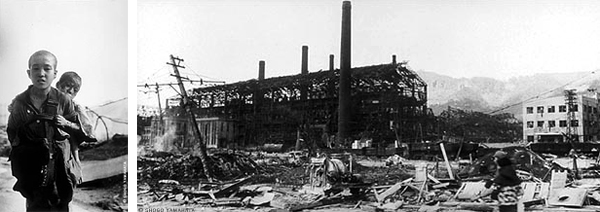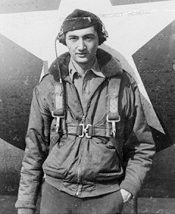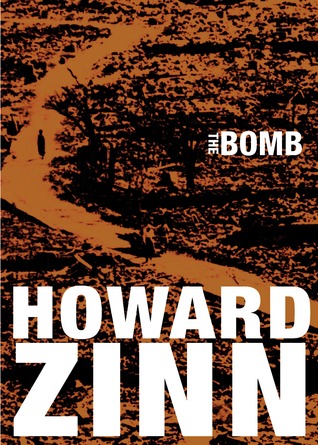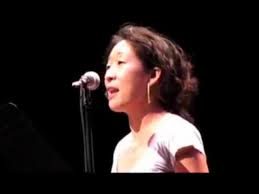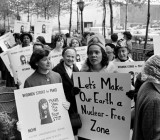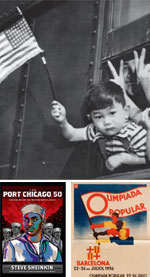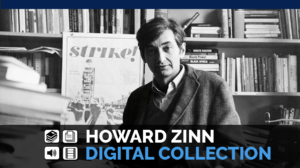August 6 and 9 mark the anniversary of the 1945 bombing of Hiroshima and Nagasaki during World War II. In the following excerpt from You Can’t Be Neutral on a Moving Train, Howard Zinn, a WWII bombardier, recalls, “Hiroshima and Royan were crucial in my gradual rethinking of what I had once accepted without question — the absolute morality of the war against fascism.” He continues, “I had become aware, both from the rethinking of my war experiences and my reading of history, of how the environment of war begins to make one side indistinguishable from the other.” Related resources on Hiroshima, Nagasaki, and WWII follow.
There was only one point during the war when a few doubts crept into my mind about the absolute rightness of what we were doing. I’d made friends with a gunner on another crew. We had something in common in that literary wasteland of an air base: we were both readers, and we were both interested in politics. At a certain point he startled me by saying, “You know, this is not a war against fascism. It’s a war for empire. England, the United States, the Soviet Union — they are all corrupt states, not morally concerned about Hitlerism, just wanting to run the world themselves. It’s an imperialist war.”
“Then why are you here?” I asked.
“To talk to guys like you.”
…
At the time I wasn’t convinced by what he said, but I was troubled by it and never forgot it. I didn’t realize myself to what extent my mind was changing during the war, but when it was over and I was putting my stuff together, I collected some photos, old navigation logs, and some other mementos, my Air Medal and ribbons with two battle stars, put them into a folder and without thinking wrote on the folder, “Never again.”
After victory in Europe, V-E Day, my crew flew back across the Atlantic in our battered B-17 (“Belle of the Brawl”). We had a thirty-day leave before going to the Pacific to take up bombing again, this time on Japan. Roz and I were heading toward a bus to take us into the country to have some time alone before my leave was over. We passed a newsstand around which people were gathered, evidently excited. A fresh pile of papers had just been delivered, and there was this huge headline: ATOMIC BOMB DROPPED ON JAPANESE CITY OF HIROSHIMA. WAR’S END EXPECTED.
I remember our reaction exactly. We were simply happy. We weren’t sure what an atomic bomb was, but it looked like just a bigger bomb than what we had been using all along. Now I wouldn’t have to go to the Pacific and the war would be over — total victory over fascism — and I would be coming home for good.
It was John Hersey’s postwar report, Hiroshima, that first made me aware of the horrors we visited on that city, made me see what we had done to a city of civilians, to old people and to schoolchildren, made me see the Japanese as human beings, not simply a nation of ferocious, cruel warriors. It led me to match the infamous “death march” on Bataan, that Japanese atrocity, with another kind of death march in Hiroshima, this time our atrocity, when dazed, burnt civilians, their flesh hanging, their eyeballs out of their sockets, their limbs torn from their bodies, walked in a stupor through the eerie remains of their flattened city under a drizzle of radioactive vapor.
…
In August of 1966, Roz and I traveled to Japan at the invitation of a Japanese peace group, to join people from various parts of the world to commemorate the dropping of the bomb and to dedicate ourselves to the elimination of nuclear weapons. We all met in Hiroshima, rebuilt now except for a few things deliberately left standing to remind people of what had happened.
One day were invited to a “House of Friendship,” a kind of community center for survivors of the bomb. We were expected to say a few words of greeting to the people there, and when it was my turn I started to say something, then looked at the men and women sitting on the floor, their faces turned to me, some without legs, others without arms, some with sockets for eyes, or with horrible burns on their faces and bodies. My mind flashed back to my work as a bombardier and I choked up, could not speak.
The following year, Roz and I, driving from Paris to the Atlantic coast, visited the rebuilt town of Royan, spoke to survivors of the wartime bombing, rummaged through documents. We found an additional motive for that senseless slaughter — the need of both the French and the American military for one more victory before the war ended.
Hiroshima and Royan were crucial in my gradual rethinking of what I had once accepted without question — the absolute morality of the war against fascism.
…
There is no war of modern times which has been accepted more universally as just. The fascist enemy was so totally evil as to forbid any questioning. They were undoubtedly the “bad guys” and we were the “good guys,” and once that decision was made there seemed no need to think about what we were doing. But I had become aware, both from the rethinking of my war experiences and my reading of history, of how the environment of war begins to make one side indistinguishable from the other.
Images: Nagasaki Journey: The Photographs of Yosuke Yamahata • Exploratorium Exhibit
More on Hiroshima, Nagasaki, and World War II
The Greatest Generation?
“They tell me I am a member of the greatest generation. That’s because I saw combat duty as a bombardier in World War II, and we (I almost said ‘I’) won the war against fascism. I am told this by Tom Brokaw, who wrote a book called The Greatest Generation, which is all about us. He is an anchorman for a big television network, meaning that he is anchored to orthodoxy, and there is no greater orthodoxy than to ascribe greatness to military valor.” Continue reading.
The Bomb
Zinn’s personal reflections and political analysis on the WWII bombing of Hiroshima, Nagasaki, Royan, and more. Learn more at here.
Yuri Kochiyama, “Then Came the War” (1991)
Sandra Oh reads Yuri Kochiyama, “Then Came the War” (1991) on Japanese internment during World War II. Watch on The People Speak page on Vimeo.com.
W. E. B. Du Bois to Malcolm X: The Untold History of the Movement to Ban the Bomb
By Vincent Intondi • July 2015
“Soon, we will commemorate the 70th anniversaries of the atomic bombings of Hiroshima and Nagasaki. Not long after comes the anniversary of the 1963 March on Washington. Students will then return to school and to their history textbooks. However, most will not learn how these issues are connected.” Continue reading at the Zinn Education Project.
Teaching Resources on World War II
Visit the Zinn Education Project for resources on World War II and on the theme of Wars and Anti-war Related Movements.
Category: Tags: Excerpts

